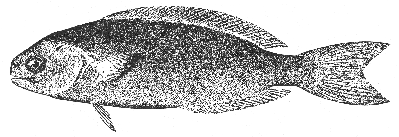Black Ruff Centrolophus niger (Gmelin) 1789
[Jordan and Evermann, 1896-1900, p. 963.]
Description—
The black ruff resembles the pilot fish (p. 372) in its general body form more than it does its closer relative the barrel fish (p. 369), being moderately slender (a little more than 1/4 as deep as it is long to base of tail fin), with very blunt snout, strongly convex forehead, and small mouth. But its body (about 21/2 times as [page 371] high as it is thick) is more flattened sidewise than that of the pilot fish; its caudal peduncle is much deeper, and has no lateral keels; its dorsal fin is considerably longer than that of the pilot fish, and there are no detached spines in front of its dorsal fin. The single dorsal fin of 3 flexible spines entirely covered over by skin and 35-38 soft rays reaches from over the pectoral fin to the caudal peduncle; the anal (3 spines concealed by skin and 20-22 soft rays) originates about under the midpoint of the dorsal and runs equally far back; both dorsal and anal fins are evenly graduated in outline from front to rear; and both are fleshy and scaly along their bases. Its ventral fins are about under the pectorals; pectorals and anals are both small; and the caudal is moderately forked.
Color—
Those we have seen (after a few weeks preservation in alcohol) are dark leaden-brown on back and sides, with the margins of the scales darkest, in so fine a pattern (because of the small size of the scales) that the general effect is sooty; the fins are darker, even, than the back; and the belly only a little paler. Other specimens have been described[42] as brownish pink all over, or brown, darkest above, some with irregular and obscure markings, either yellowish or dark blue.
Size—
Grows to about 2 feet in length.
General range—
Oceanic, and widespread in low and mid latitudes in the eastern North Atlantic; Madeira, the Azores, and the coasts of Spain north to the entrance to the English Channel, the Celtic Sea and southern Norway; also in the Mediterranean; and reported as a stray from Massachusetts and from Georges Bank.
Occurrence in the Gulf of Maine—
One specimen of this wanderer from Europe, about 123/4 inches long, was taken in a trap at North Truro on Cape Cod Bay, September 6, 1890;[43] a second of 211/2 inches was brought in from the northern edge of Georges Bank by the trawler Thomas Whalen in September 1936;[44] and a third of about 13 inches (330 mm.) to the fork of the tail was taken in a trap at North Truro June 23, 1951.[45]
Another about 9 inches long was taken in 1888[46] at Dennis, Mass. But it is not known whether this record should be credited to our Gulf or to the southern coast of Massachusetts, since that township fronts both on Cape Cod Bay and on Nantucket Sound.
[42] Day, Fishes Great Britain, 1880-1884, vol. 1, p. 110.
[43] Reported by Bean, Proc. U. S. Nat. Mus., vol. 21, 1898, p. 639 and now in the U. S. National Museum.
[44] Reported by Bigelow and Schroeder, Copeia, 1937, p. 61.
[45] Received through the kindness of John Worthington of the Pond Village Cold Storage Co.
[46] Goode and Bean, Smithsonian Contrib. Knowl., vol. 30, 1895, p. 214.
